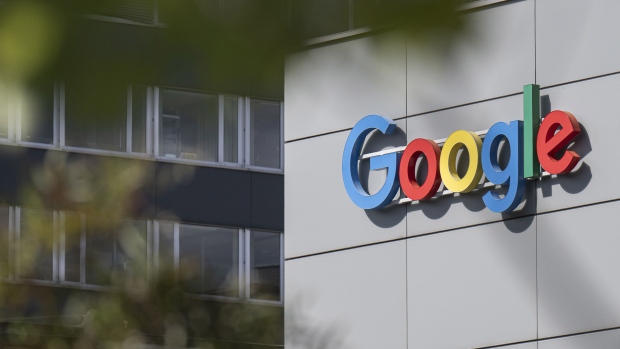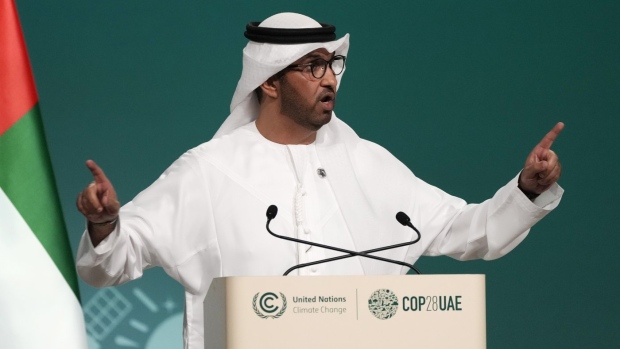Canadian oil and gas execs look to talk up emissions reduction plans at COP28 summit
Amanda Stephenson, The Canadian Press
Executives and senior leaders from Canada's oil and gas sector are heading to Dubai for the upcoming United Nations COP28 climate talks, eager to tell the world they are doing what they can to reduce greenhouse gas emissions.
The fossil fuel industry will have a position of prominence at this year's climate summit, which begins Thursday.
Hosted by the United Arab Emirates — which pumps about three million barrels of petroleum products each day — and chaired by Sultan al Jaber, an Emirati who is also CEO of the Abu Dhabi National Oil Company, the 2023 COP event will put oil companies in the spotlight even as it seeks to find ways to hold the line on global warming.
Among the Canadian oil and gas sector representatives headed to the summit are a contingent from the Canadian Association of Petroleum Producers (CAPP) industry group and a team from the Pathways Alliance consortium of oilsands companies.
CAPP president Lisa Baiton said in an email the group is going to "contribute to the dialogue" on global decarbonization efforts, while Pathways Alliance president Kendall Dilling said his organization wants to collaborate with other industries around the world who face similar challenges when it comes to emissions.
"We're going there in a very constructive way to say, ‘We’re here, we’re a big source of emissions and we’re going to be a big part of the solution,'" Dilling said in an interview.
“I think we have something to offer, frankly ... we're an entire sector that’s come together jointly to tackle this problem."
As the world's fourth largest oil producer and this country's heaviest-emitting sector, Canada's oil and gas industry is under increasing pressure to decarbonize to help this country meet its international climate commitments.
The federal government wants to see Canada's oilpatch reduce its emissions by 31 per cent below 2005 levels, or 42 per cent below 2019 levels, to 110 million tonnes by 2030.
The government has promised to impose an emissions cap on the sector, something environmentalists say is necessary but is widely reviled by industry and viewed as akin to a production cap.
But even in the absence of domestic pressures, Canadian oil and gas companies have a business incentive to cut emissions.
Many analysts believe Canadian oil and gas companies are facing a future scenario in which only the cheapest and lowest-emission producers will remain competitive long-term as the energy transition accelerates.
"Certainly, the world is seeking to lower emissions, full stop, and at the same time, we're seeing demand for fossil fuels continue. So decarbonization has become a metric of competitiveness," said Kevin Birn, vice-president and Canadian oil markets chief analyst with S&P Global.
"I think that's the reason you see increasing participation (at COP) as they attempt to understand these latest developments and adapt to the market signals that are coming," he said.
Within the last 18 months, the Canadian oil and gas sector has rolled out a flurry of announcements of proposed projects — from hydrogen plants to renewable diesel facilities to carbon capture and storage — aimed at lowering the industry’s emissions profile.
The Pathways Alliance, which says it has spent $1.8 billion since 2021 on decarbonization efforts, says it's eager to talk about some of its emissions reduction plans — including a proposal to spend $16.5 billion to build a massive carbon capture and storage network in northern Alberta.
"We know that it’s critical to the future of our business and to the sustainability of our sector," Dilling said, adding that international climate targets will never be met if heavy emitters aren't at the table for events like COP28.
"Whatever targets are ultimately landed on, it’s industry writ large who have to execute on those emission reduction targets."
Janetta McKenzie, a senior analyst with clean energy think-tank the Pembina Institute, said oil and gas participation in the UN climate summit is a positive thing.
"Their presence at COP does indicate that they see how things are changing," she said.
"They see that the energy transition is not coming, it is here — and it is gaining momentum every year."
But McKenzie also warned against the potential for "greenwashing," a term used to describe the use of misleading or deceptive environmental claims by corporations, to occur at COP28.
She said many oil and gas companies have so far made a lot of climate promises but have yet to invest the tens of billions of dollars needed to see those promises through.
"We've seen a lot of announcements, we've seen a lot of targets. Those are great first steps. But we haven't seen a lot of real absolute investment in technology that would reduce emissions from the sector," she said.
"We've seen a lot of talk. We're looking to see more action to back up that talk."
Canadian oil production is expected to hit an all-time high within the next two years, according to a recent Deloitte report.
The vast majority of the increase in Canadian oil production is expected to come from the oilsands, where companies are working on thermal expansion projects that will link new assets with existing facilities to speed up development at a lower cost.
However, oilsands bitumen also has a higher emissions profile than oil from many other parts of the world because of the large amounts of energy needed to produce and transport it.
COP28 President Sultan al-Jaber speaks during the opening session at the COP28 U.N. Climate Summit, Thursday, Nov. 30, 2023, in Dubai, United Arab Emirates. (AP Photo/Peter Dejong)
Pressure to phase out fossil fuels mounted Thursday on the oil company chief who took over fragile international climate negotiations that opened in Dubai amid concerns about what some say is contradictory dual roles.
The climate talks newly installed boss began on the hot seat and not just because the planet keeps smashing heat records this year. Days before the United Nations Conference of Parties (COP28) began, reports published meeting preparation notes that linked efforts by the United Arab Emirates national oil company ADNOC to push fossil fuel sales at the same time its CEO and new COP president, Sultan al-Jaber, was meeting to curb climate change. Burning coal, oil and gas is a chief cause of global warming.
Even though al-Jaber vehemently denied the revelations from the BBC and others, several climate negotiations experts say it will likely change the tenor and maybe even the outcome of the two weeks of intense negotiations, taking place about 100 kilometers from where five offshore oil fields flow.
“I think the pressure on the COP president to deliver is pretty clear and has been clear for months,” German climate envoy Jennifer Morgan told The Associated Press. “That’s the focus here to deliver on really a course correction.”
Climate negotiations historian Joanna Depledge said, “whether true or not, the revelations are embarrassing, but I don’t think they put COP in jeopardy. To the contrary, the hope is that the pressure on UAE will tighten.”
And that may mean the UAE will contribute more money to a newly established compensation fund to climate change victims and maybe even tighter language on fossil fuel use, Depledge said.
In a clear effort to start off strongly, negotiators addressed another hot topic—money to help poor countries victimized by floods, storms and droughts—in the first session. Leading the opening meeting, al-Jaber and the United Nations body approved putting a compensation fund for climate change victim nations into operation with host United Arab Emirates and Germany each pledging US$100 million to the new fund, the United Kingdom kicking in up to $75 million and the United States another $17.5 million.
“It’s understandable if the COP hosts, and other fossil fuel nations, were starting to feel the heat on this issue," said Mohamed Adow, of Power Shift Africa. "Fossil fuels are after all the elephant in the room and these countries can’t go on trying to pretend they are not a problem. This extra scrutiny is certainly welcome.”
Al-Jaber’s two positions were already a source of mistrust. The news coverage brings even more attention to the role of coal, oil and gas in climate change at climate talks and highlights efforts to eliminate use of fossil fuels said, World Resources Institute president Ani Dasgupta.
“On one hand, the disclosures erode trust in the COP president and that will make forging a deal harder,” said former U.S. State Department climate lawyer Nigel Purvis, CEO of Climate Advisers. “On the other hand, the UAE now has even more reason to push for a fossil fuel phase-down agreement to show the world that it is serious about becoming the first post-petroleum OPEC country.”
Morgan said Germany and Europe were steadfast in their support for a phase out of fossil fuels and on Wednesday U.S. climate envoy John Kerry said the United States continues to favor a phase out.
A spokesman for the COP presidency office said, “Any pressure felt by the COP Presidency stems from the urgency to deliver ambitious action to course correct and keep 1.5C (the 2015 adopted international climate threshold) within reach.”
Climate Analytics CEO Bill Hare said the UAE has pushed for a less stringent “phase down” instead of a stricter “phase out” of fossil fuels. He called the phase down phrase “window dressing” for increased oil and gas drilling.
Recent reporting “absolutely reinforces everyone’s concerns about greenwashing,” Hare said Thursday. “And that means that the COP president needs to stand back from his oil interests and look at the interests of the planet as a whole.”
Hare, like Dasgupta, Purvis, Depledge and others, said in the end the reporting will mean al-Jaber and oil interests will have to shepherd a stronger agreement to get rid of fossil fuels.
United Nations climate chief Simon Stiell told negotiators that he was sick of the “baby steps” taken so far to fight climate change, challenging them to do far more and faster.
“If we do not signal the terminal decline of the fossil fuel era as we know it, we welcome our own terminal decline,” Stiell said. “And we choose to pay with people’s lives.”
Minutes after taking the gavel on the first day of climate negotiations, al-Jaber referred to the need for change in the way the world gets its energy.
“I know there are strong views on the idea of including language on fossil fuels,’’ al-Jaber said. “I ask you all to work together. Be flexible. Find common ground. Come forward with solutions and achieve consensus.”
Yet he also talked about the “bold choice” of including oil companies more in climate talks and the push for net zero industry emissions by 2050.
WRI’s Dasgupta said there’s extra pressure right now because globally multilateralism – when countries work together on issues – is under attack, especially because of recent wars in Ukraine and Gaza and the way the COVID-19 vaccine was distributed. Add to that record heat this year, he said.
“We’ve seen already at 1.2 degrees warming this year the catastrophic heatwaves, floods and other events that have happened around the world,” Climate Analytics Hare said. “We are facing epic wreckage here. If we can’t get this problem under control.”
Al-Jaber said he hopes negotiators over the next two weeks can change things.
“Let’s restore faith in multilateralism,” al-Jaber said. “Let’s deliver some good news to the world that really needs it today.”
___
Read more of AP’s climate coverage at http://www.apnews.com/climate-and-environment.
Follow Seth Borenstein on X, formerly known as Twitter, at @borenbears
Associated Press climate and environmental coverage receives support from several private foundations. See more about AP’s climate initiative here. The AP is solely responsible for all content.


